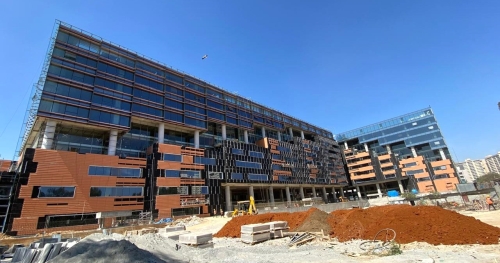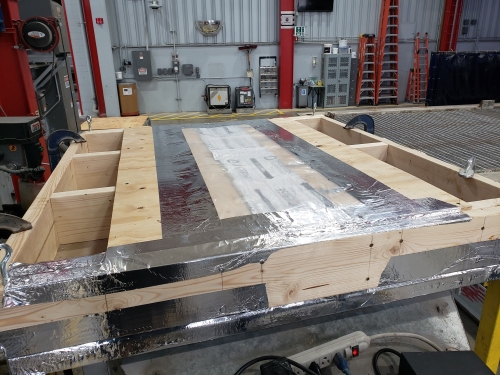What is India’s IS 18190: 2023 test for perimeter fire barrier joint systems in curtain walling?
In June 2023, the Bureau of Indian Standards (BIS) released IS 18190: 2023 - Fire Resistance of Perimeter Fire Barrier Joint System1 to help define the performance requirements for curtain wall passive fire protection measures across the nation. In this Insights blog, we will explore the new standard, what it considers, and the benefits that it can bring to the long-term safety of India’s built environment.

[1] Bureau of Indian Standards (2023) IS18190: 2023 : https://www.services.bis.gov.in/php/BIS_2.0/bisconnect/standard_review/Standard_review/Isdetails?ID=MjkxMzU%3D
Why was IS 18190: 2023 introduced?
The National Building Code (NBC) 2016 states in clause 3.4.10.2. that “All gaps between floor-slabs and façade assembly shall be sealed at all levels by approved fire resistant [sic] system of equal fire rating as that of [the] floor slab to prevent fire and smoke propagation from one floor to another.”2 Historically, this fire resistance rating has been determined by various test standards developed by bodies in different regions, such as Europe (EN) and the USA (ASTM).
To provide a national alternative, IS 18190: 2023 was created. The standard outlines how to carry out fire resistance tests to assess the performance of perimeter fire barrier assemblies installed within the spandrel zone. It draws on widely used standards ASTM E2307-20 (now superseded by ASTM E2307-25) - Standard Test Method for Determining Fire Resistance of Perimeter Fire Barriers Using Intermediate-Scale, Multi-story Test Apparatus, as well as UL 2079 – Tests for Fire Resistance of Building Joint Systems to create a robust approach that clearly demonstrates how the chosen solutions performs in relation to the floor-to-floor spread of flames, toxic gases and heat, as well as smoke migration.
[2] Bureau of Indian Standards (2016) National Building Code: https://www.bis.gov.in/standards/technical-department/national-building-code/
What does IS 18190: 2023 consider?
Movement cycling
Before the test begins, the perimeter fire barrier system is subject to movement cycling between the minimum and maximum joint width, at a rate designated by the test applicant 24 hours before fire exposure. This is to simulate the dynamic movement of the curtain wall system. Once complete, the assembly is checked to see if there is any “indication of stress, deformation, or fatigue of the test specimen.” (Note - a perimeter joint is considered ‘static’ when its maximum and minimum joint widths are equal, meaning it will not move. A perimeter joint is considered ‘dynamic’ when the maximum joint width is greater than the minimum joint width as it is capable of movement1).
Fire resistance
The test uses intermediate scale multi-storey apparatus (ISMA) to better replicate a fully developed curtain wall fire. The system is exposed to fire from both inside and outside the test compartment to simulate the room where the fire started, as the fire plume exits the room of origin through a window opening and attempts to leapfrog to the next floor.
The first 30 minutes of the test follows the time-temperature curve defined in the NFPA 285 standard, which evaluates the “fire propagation characteristics of exterior wall assemblies containing combustible components.” The test then follows the fire curve defined by ISO 834-1: 1999— the international standard for fire-resistance tests. The perimeter fire barrier system subsequently receives T and F-ratings.
Its F-rating, or fire resistance rating (sometimes referred to as ‘integrity’), is determined at the time either when flames penetrate through the perimeter firestop system or around its boundaries, or when the cotton pad applied to the opposite side of the fire gets hot enough to ignite. (An additional failure criterion to ASTM E2307-20 / 25 is failure through openings within the upper spandrel section of the curtain wall situated above the perimeter firestop system).
Its T-rating or temperature rise (sometimes referred to as ‘insulation’) is set at the time where the average temperature recorded by any of the thermocouples installed on the unexposed surface of the perimeter fire barrier system and the interior face of the curtain wall rises more than a defined temperature determined by the joint width being tested e.g. +180°C for joint widths ≥100mm and +139°C for joint widths >100mm.
Air leakage
While not mandatory, air leakage — measured as the L-rating in accordance with UL 2079 — is highly recommended. Standards & Programs Manager, Manjunath Vittala Rao, of UL (Underwriters Laboratories) explains:
“This test evaluates the ability of perimeter firestop systems to restrict smoke movement by measuring air leakage at both ambient and elevated temperatures. The test is conducted using a sealed chamber with controlled airflow and pressure differential, simulating real-world conditions. The results help determine the suitability of firestopping systems for protecting floor openings and smoke barriers, aligning with NFPA (National Fire Protection Assembly)101 Life Safety Code requirements3 By incorporating L-rating data, authorities and designers can make more informed decisions about smoke migration control, enhancing overall life safety in buildings."
[3] UL Solutions - Firestop and Joint Application Guide
What is the difference between IS 18190: 2023 and ASTM E2307-20 / 25?
Many perimeter fire barriers available on the Indian construction market carry ASTM E2307-20 / 25 testing to verify their fire performance. Whilst this is a robust and valid test in and of itself, it is important to understand how it differs from IS 18190: 2023 and that it is not an equivalent standard.
Whilst both tests use the same testing apparatus and methodology, ASTM E2307-20 / 25 has been developed to only look specifically at the performance of the perimeter fire barrier seal— not the perimeter fire barrier system that includes the spandrel. The IS 18190: 2023 standard also more closely aligns with international standards by using the ISO 834-1: 1999 time-temperature curve.
Another key difference is the provision for testing air leakage rates. In a fire, more casualties and deaths occur due to inhaling the smoke generated from the burning building contents than burns, especially as smoke can travel much faster than the fire itself. Being able to ensure that the chosen perimeter fire barrier system will maintain a tight floor-to-floor seal is therefore crucial in safeguarding the safety of building occupants
Notwithstanding the above, it is important to note that any test results apply only to the specific perimeter fire barrier system used, and changing any of the components within a project specification will mean that the system does not meet the requirements of the test standard.

Why should the Indian façade industry begin to adopt IS 18190: 2023?
IS 18190 is an Indian standard developed specifically to protect buildings and people from the effects of fire. Whilst it is still only a recommendation at this stage, its holistic, system approach goes beyond both current standards here, and those that have been developed elsewhere in the world. Adopting the standard and sourcing passive fire protection systems that have been tested to it can not only help to preserve the integrity of curtain wall assemblies and ensure effective compartmentation in the unfortunate event of a fire but also set India at the forefront of global efforts to improve curtain wall fire safety. The standard will be reflected in the upcoming version of the NBC (National Building Code) as well ensuring all current and ongoing constructions will be future proofed and aligned with the code.
Contact us
We're here to help you
Call for our main switchboard
Email us for technical enquiries
Email us for site support
Complete the form for the right response